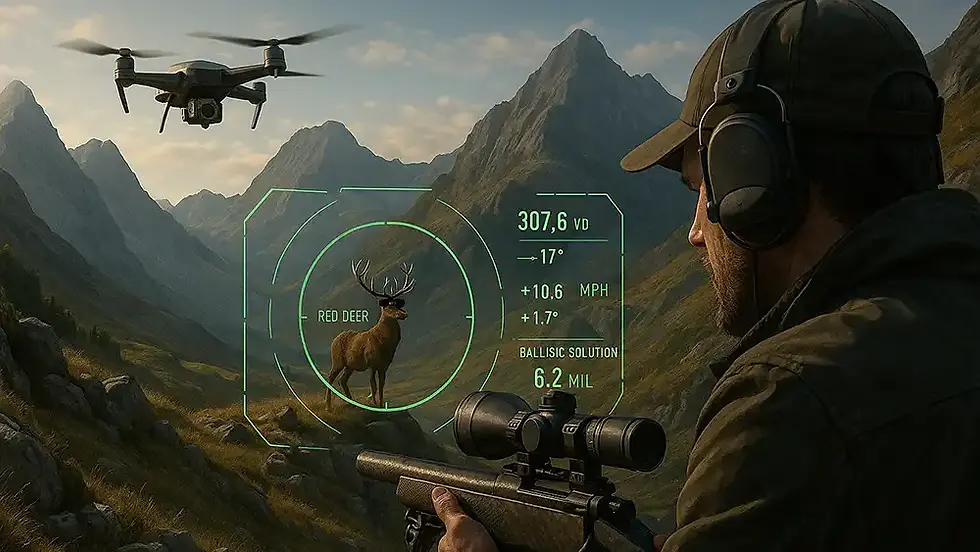A Hunting Day in 2040 – Silence in the Digital Woods
- Hans ARC
- Nov 4
- 4 min read

It’s 4:27 a.m. A pale light hovers over the forest — not the moon, but the soft pulse of a reconnaissance drone sweeping silently above the treetops. It scans the terrain, detects wildlife movement, measures wind and temperature. On the hunter’s retina display, the live feed appears in real time — soundless, seamless, second by second.
The rifle in his hand weighs barely five pounds. Carbon-titanium composite, balanced to perfection. The barrel isn’t screwed in anymore — it locks magnetically. The entire system is CO₂-neutral, built from recycled alloys and bio-resins. No muzzle flash, no smoke, no sound. The trigger isn’t a mechanical click, but a digital impulse — released only by biometric authorization.
The hunter moves quietly through a forest that’s now a living network. Trees carry sensors monitoring microclimate, soil health, and biodiversity. Hunters, foresters, and scientists share the same data in real time. On his app — once a simple game log, now an ecological dashboard — population trends and alerts pulse in glowing icons.
In a hollow veiled in morning fog, the thermal lens picks up a shape: a mature buck, four years old, in prime condition. Instantly, the AI inside the scope analyzes and identifies — age, weight, condition — cross-referenced from tens of thousands of datasets.
But the hunter doesn’t raise his rifle.
He breathes. Waits. Decides.
Because even in 2040, one thing hasn’t changed: hunting remains an act of conscience.
He lowers his weapon. On the HUD, his vitals appear — heart rate 62, body temp 97.5°F, calm. The rifle powers down automatically and sends a digital log to the wildlife management system. No shot fired. Just awareness gained.
As he descends through the trees, he turns off the HUD. Only wind, snow, and sunlight remain. For a moment, everything feels like it once did. Perhaps that’s the greatest triumph of the future — that it teaches us to be present again.
The Future of Hunting
The future of hunting isn’t science fiction — it’s already unfolding.
Thermal scopes detect game hundreds of yards away, ballistic computers calculate perfect trajectories, and AI systems can now distinguish between a deer, a boar, or a dog.
But what technology can never replace is judgment.
Even in a world of digital optics and data-driven rifles, the hunter’s core responsibility remains the same: to decide — ethically, instinctively, humanly.
Technology can make us see better. But it can’t make us wiser.
Hunting has always been guided by heart as much as by crosshairs.
Sustainability as a New Instinct
Climate change is reshaping the landscape — literally. Wild boar are moving higher into alpine zones, red deer are retreating deeper into the woods, and new species like the golden jackal are on the rise.
Tomorrow’s hunters will be more than marksmen — they’ll be ecological stewards.
They’ll share real-time data with foresters and biologists, mapping migrations, tracking populations, managing balance. Every shot fired will be logged, every harvest recorded in the living map of the ecosystem.
Hunting will become data work — and yet, it will remain a dialogue as old as time: between human and wild.

The Weapon as a Mirror of Its Era
The hunting rifle of tomorrow won’t just be forged steel — it will be a symphony of precision, sensors, and conscience.
Carbon, titanium, and dampening tech will make rifles lighter, quieter, cleaner. Caliber obsession will give way to a new philosophy: less recoil, more control; less noise, more respect. Digital triggers, built-in ballistic computers, biometric safeties — tools for smarter responsibility.
But true progress won’t lie in circuitry — it will lie in ethics.
Technology only matters when it serves the right purpose: a clean shot, a humane harvest, a conscious decision.
Perhaps soon, every rifle will document its own history automatically. Perhaps one day, barrels will be made from renewable composites, crafted in solar-powered workshops.
And maybe the finest rifle of all will be the one you use the least — because you’ve learned that sometimes observation is the highest form of respect.
Between High Tech and Holy Silence
The future of hunting will stand on two pillars: innovation and introspection.
Some will hunt through augmented-reality scopes, others will turn them off deliberately. Some will use drones for tracking, others will still trust their dogs.
Both paths are valid — as long as respect remains the compass.
What Will Never Change
No matter how the world evolves — through technology, climate, or culture — hunting will never lose its soul.
Even in the year 2040, when rifles self-log every shot and optics calibrate via Bluetooth, the hunter will still pause after the chase, look up at the dawn sky, and feel the quiet pulse of the living forest.
And he’ll know: hunting was never just a craft.
It was always a calling.




Comments